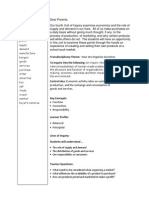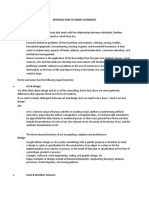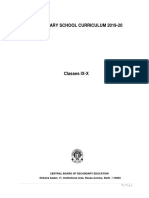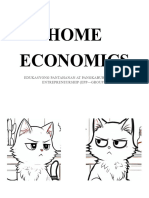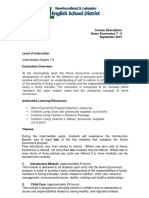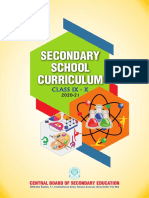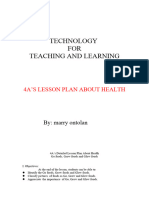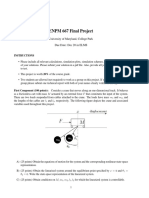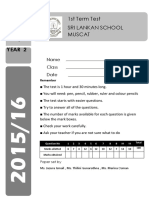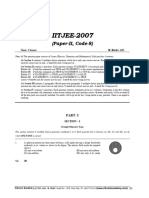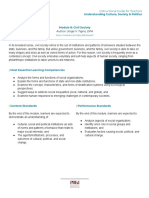Consumer Science Education
Introduction to Consumer Science (CS)
CSc is defined as a field of study and that profession which enables rational judgment to domestic life.
The focus of CSc is the family, in which there has to be an optimum balance between people and their
environment. There are different areas in Consumer Science and each contributes to the welfare of the
individual, family and the environment.
History of CS in ESwatini:
In primary schools Consumer Science was introduced in the early 1940s and the subjects taught were
cookery, with either Laundry work or House wifery. In the 1950s, it was taught by Consumer Scientists
extension workers to women clubs around the country and as a result prison clubs were initiated
whereby the women prisoners were taught some useful skills for use when they have been released.
Government supported these ventures by providing a small grant for each student to buy ingredients
and also supplied needlework materials.
In Secondary schools CSc was introduced in 1951, and in 1955 it progressed to O’ level. During this time
the schools offered either Cookery or needlework. There was great emphasis on teaching skills, but
concepts and underlying principles were left out. Later on it was taught as options which were Domestic
science, Home management and Needlework.
New developments in the subjects:
Following new developments in the subject worldwide, there was a move towards the integration of all
related CSc fields resulting in the study being called Home Economics. However due to the scientific
nature of the subject this has since been changed to Consumer Science. In our country (Eswatini) this
name change was launched in 2012 in Nhlangano for all concerned institutions to adopt.
The teaching of Consumer Science serves three folds:
• Preparation for future personal and family responsibilities.
• Preparation for wage earning (self-employment /Entrepreneurship).
• As one of the subject considered for entry into tertiary institutions.
The content areas taught in CSc are:
Home management
Nutrition
Child care and development.
Family living
Health and hygiene
Clothing and textiles.
Food preparation
1
� Laundry and
Consumer education.
Some General aims of CS are to:
a) Create an interest in the home and environment and make pupils aware of their roles in
the home and community.
b) Develop an awareness of various skills required in cookery, Needlework and other
household tasks, and to relate the theory involved in each of these components.
c) Encourage good Nutrition
d) Encourage responsibility in the use of resources.
e) Make pupils aware of their roles as consumers and the principles relating to the
purchase of food, clothes, and interior accessories with regard to labeling, price and
quality.
f) Introduce pupils to elementary financial transaction and budget planning.
g) Develop the ability to apply knowledge in respect of home management principles.
h) Develop awareness of the demand of vocational and home making roles.
Objectives for CSc are:
a) To impart the Philosophy of Consumer Science to student teachers who will in turn,
impart the knowledge to primary school pupils.
b) To enable students to economize by wise management of family resources.
c) To help students to be able to promote, re-discover, appreciate, utilize and develop
local indigenous commodities.
d) To teach students on how to care for members of the family at different life stages.
e) To alert students on their roles as consumers in the economy.
f) To equip students as resource people in the community on matters concerning HE.
g) Equip with skills in food preparation, needlework craft.
The place of Consumer Science in the school curriculum
At Secondary and high school level it comes as:
Consumer Science (Junior level)
Food and nutrition
Fashion and fabrics
Family living and resources
Child care and development
Home management
Pre- vocational Home Economics
2
�At primary school level it is treated under:
Consumer Science as a subject (Grade 5 to 7)
Professionalism in relation to Consumer Science
Following are some characteristics associated with Consumer Science teacher conduct, just like any
other teaching field:
1. Keep up to date with issues on subject matter, through the use of local, national and
international sources.
2. Always meet obligations and commitments fully and on time.
3. Wear appropriate clothing for the occasion.
4. Manage time effectively.
5. Render services and show concern for people.
6. Be loyal to colleagues.
7. Assume responsibility for personal behaviour.
8. Seek and accept advice and criticism objectively.
9. Maintain a sense of humour.
10. Maintain high work standards.
11. Get involved in community, professional organizations and legislative matters.
12. Possess good communication and public relation skills.
13. Express ideas objectively, clearly and concisely.
14. Maintain good physical, mental and emotional health.
15. Keep your word.
Be an effective teacher through the following:
a) Having a thorough knowledge of the subject matter to be taught.
b) Be able to organize that knowledge according to the needs of the institution in which you teach.
c) Plan courses suitable for the ability and maturity of the pupils in light of any outside constraints
e.g. exams.
d) Be able to break down courses into manageable parts i.e. terms, weeks and individual lessons.
e) Appreciate and demonstrate the value of the subject taught, both for its own sake and the part
it plays within the school curriculum.
f) Appear well groomed, neat and smartly dressed.
g) Have the will to teach pupils to enjoy work and reach the goals you have set together.
h) Cultivate a clear and well-modulated voice.
i) Be firm and fair, and treat people the same.
3
�j) Discipline learners with kindness and good humour.
k) Develop a good memory.




